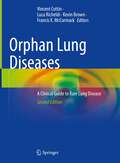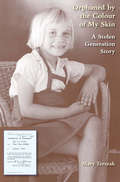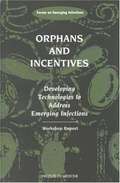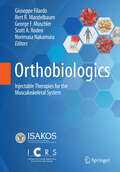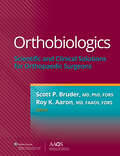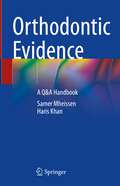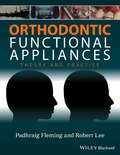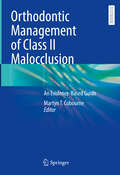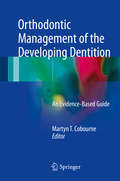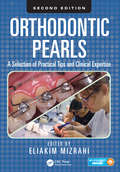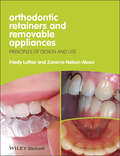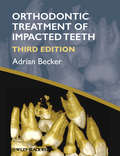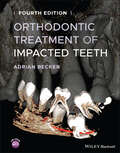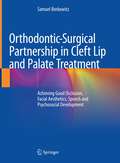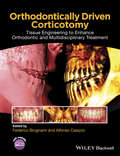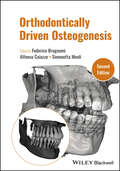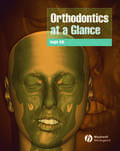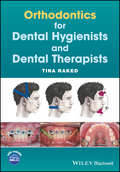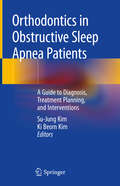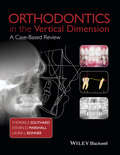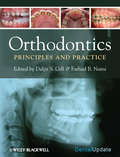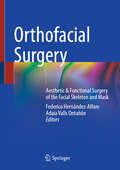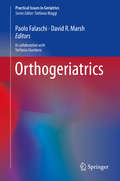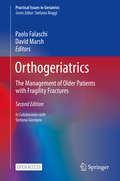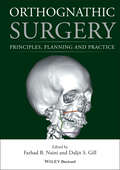- Table View
- List View
Orphan Lung Diseases: A Clinical Guide to Rare Lung Disease
by Vincent Cottin Luca Richeldi Francis X. McCormack Kevin BrownThe second edition comprehensively reviews the wide field of rare pulmonary diseases. Issues such as less common diseases affecting the airways, systematic disorders with lung involvement, interstitial lung diseases, and many other orphan conditions of the lungs are explored in this book. The progress and advances made in the field and the limited number of patients presenting each condition makes it very difficult for clinicians to be up-to-date in this field. Readers will discover how to diagnose and manage these rare orphan diseases. Orphan Lung Diseases: A Clinical Guide to Rare Lung Disease is a practical, informative book written by a team of international authors with much experience in rare pulmonary diseases Orphan Lung Diseases: A Clinical Guide to Rare Lung Disease, second edition provides synthesized and easily accessible information about the main orphan lung diseases, to aid clinicians in charge of patients with rare disease, or who consider the diagnosis of a rare disease in their patient. It is a practical, informative guide written by a team of international experienced authors in rare pulmonary diseases.
Orphaned by the Colour of My Skin: A Stolen Generation Story
by Mary TerszakIn an invasive, paternalistic, federal public policy environment for Indigenous communities, this book provides an in-depth account of one person's experiences as a 'Stolen Generation' Aboriginal Australian. Told from the heart, the book speaks in the raw voice of a grandmother reflecting on her life, focusing on her childhood experiences, subsequent perceptions and life stories. The book presents a rare autobiographical journaling of the psychological impact of institutionalisation on an Indigenous woman, her search for family, community and identity, her psychological breakdown and her personal reconstruction through telling her story in a supportive educational environment. As an Appendix, the author provides us with a critical analysis and autoethnography - using her story as a case study - that provides deep insights into the personal experience of dealing with forced institutionalisation and social engineering to assimilate Aboriginal people.
Orphans and Incentives: Workshop Report
by Forum on Emerging InfectionsInfectious diseases remain a leading cause of prolonged illness, premature mortality, and soaring health costs. In the United States in 1995, infectious diseases were the third leading cause of death, right behind heart disease and cancer. Mortality is mounting over time, owing to HIV/AIDS, pneumonia, and septicemia, with drug resistance playing an ever-increasing role in each of these disease categories. This book, a report from a Forum on Emerging Infections workshop, focuses on product areas where returns from the market might be perceived as being too small or too complicated by other factors to compete in industrial portfolios with other demands for investment. Vaccines are quintessential examples of such products. The lessons learned fall into four areas, including what makes intersectoral collaboration a reality, the notion of a product life cycle, the implications of divergent sectoral mandates and concepts of risk, and the roles of advocacy and public education. The summary contains an examination of the Children's Vaccine Initiative and other models, an industry perspective on the emerging infections agenda, and legal and regulatory issues.
Orthobiologics: Injectable Therapies for the Musculoskeletal System
by Norimasa Nakamura Bert R. Mandelbaum Giuseppe Filardo George F. Muschler Scott A. RodeoThis book presents the evidence related to the use of injectable biologics to provide faster and better healing for musculoskeletal lesions and conditions. The authors discuss approaches, such as blood derivatives and cell concentrates, applied to lesions of muscles, ligaments, tendons, bones, meniscus and cartilage, as well as osteoarthritis. Chapters are written by some of the most influential opinion leaders in the field, with up-to-date review of the current literature, where the authors explore both the potential and the limitations of these minimally invasive and promising treatments.The first section is devoted to the formulations and rationale for the use of injectable orthobiologics, while the second section reviews current treatment methods applied to specific joints and pathologies – ranging from tendinopathies through non-unions to articular degenerative processes – as well as the results of these treatment approaches. The third section explores future perspectives, such as pluripotent stem cells, gene therapy, and the stimulation of intrinsic stromal cell niches. Appealing to a broad readership, this book will be of interest to both laboratory research scientists and clinicians, including orthopedists, sports physicians, physiatrists, and regenerative medicine experts.
Orthobiologics: Scientific and Clinical Solutions for Orthopaedic Surgeons (AAOS - American Academy of Orthopaedic Surgeons)
by Scott P Bruder Aaron RoyDeveloped in partnership with the American Academy of Orthopaedic Surgeons (AAOS) and edited by internationally renowned experts Drs. Scott P. Bruder and Roy K. Aaron, Orthobiologics: Scientific and Clinical Solutions for Orthopaedic Surgeons provides authoritative, comprehensive coverage of this fast-growing field. This one-stop reference is an ideal resource, covering technology and basic science through specific clinical applications.
Orthodontic Evidence: A Q&A Handbook
by Samer Mheissen Haris KhanThis book helps clinicians and postgraduate students to better understand the evidence in orthodontics and to use an evidence-based approach in their clinical practice. The book is written in a question-and-answer style, and each question is answered according to the hierarchy of evidence. At the end of each answer, an interpretation of the included systematic reviews, randomized clinical trials, or other studies is summarized and critically reviewed to give a better understanding of the evidence. This book covers a wide range of clinical topics, such as the treatment of Class II and Class III malocclusion, molar distalization, impacted canines, maxillary expansion, and temporary anchorage devices. Valuable material is provided on root resorption, white spot lesions, and orthodontic retention. As the book is written in Q&A style, it would be helpful to find the most relevant question without going through the whole chapter. The book includes the most asked questions about clinical orthodontics in discussions and will be a great help for orthodontist to defend their seen and unseen cases in exam.
Orthodontic Functional Appliances: Theory and Practice
by Padhraig S. Fleming Robert C. LeeComprehensive specialist manual covering the science and practice of functional appliance therapy Integrates clinical and academic elements with emphasis on evidence-based research and its clinical application Suitable for trainee and practicing orthodontists Includes more than 600 photographs to enhance clarity of topics covered Features contributions from top clinicians and researchers in the field
Orthodontic Management of Class II Malocclusion: An Evidence-Based Guide
by Martyn T. CobourneThis multi-author clinical guide provides an evidence-based account of the orthodontic management of class II malocclusion. It begins with an overview of class II malocclusion including clinical examples and epidemiological data. This is followed by a chapter discussing timing of treatment, both early and late, and pre- and post-pubertal interventions. Information is given on the evidence base underlying outcomes of treatment, and on clinical management of class II malocclusion, beginning with techniques aimed at growth modification including removable functional appliances, fixed functional appliances and molar distalisation. The book includes a stand-alone chapter on class II division 2 malocclusion and explains conventional camouflage-based orthodontic treatment, treatment of class II malocclusion with lingual appliances and orthodontic-surgical management of class II cases. The last chapters are dedicated to management of class II cases with aligners and retention. In this book, there is an emphasis on evidence-based management of these developing problems and each chapter is richly illustrated with clinical examples. The chapters have been written by an international field of expert clinicians and academics, and will appeal to a wide range of clinicians, including undergraduate dental students, orthodontic specialist trainees and established specialist orthodontists.
Orthodontic Management of the Developing Dentition
by Martyn T. CobourneThis multiauthor clinical guide provides an evidence-based overview of orthodontic management during development of the dentition. It begins with an illustrated account of normal dental development and then covers the management of problems that are commonly seen during this process. These include acquired problems, such as caries, space loss and dental trauma, developmental anomalies, including variation in tooth number and eruption defects. In addition, detailed consideration is given to the interceptive management of class II and class III malocclusion and transverse discrepancies. There is an emphasis on evidence-based management of these developmental problems and each chapter is richly illustrated with clinical examples.
Orthodontic Pearls: A Selection of Practical Tips and Clinical Expertise, Second Edition
by Eliakim MizrahiOrthodontic Pearls: A Selection of Practical Tips and Clinical Expertise synthesizes a wealth of information gleaned from clinical and administrative experiences in orthodontic practice. The administration and running of an orthodontic practice is not often taught extensively or formally in most schools. This book fills that gap by providing tips,
Orthodontic Retainers and Removable Appliances
by Friedy Luther Zararna Nelson-MoonThis book is a practical guide for both dental students and practitioners to designing, fitting and adjusting removable orthodontic appliances and retainers. The book offers step by step instructions with clear illustrations on the key areas of clinical practice. In each case, information is provided on indications for use, principles of design, fitting, activation and trouble shooting. Further chapters coach students to deal effectively with their patients and to manage the treatment plan in question.
Orthodontic Treatment of Impacted Teeth
by Adrian BeckerOrthodontic Treatment of Impacted Teeth provides its readers with a gold-standard resource to tackle common, complex and multi-factorial clinical scenarios. Rooted firmly in the scientific reality, it also provides a valuable repository of the evidence-base for this subject area. The third edition of this classic text has been fully revised and updated to reflect the latest advances in research and clinical practice. It discusses recent developments in the periodontal outcome of surgical exposure of impacted teeth, and also incorporates more protocols for routine cases. This enables clinicians to develop their skills in the simpler cases, as well as to improve their understanding of complex and rare presentations. An especially useful chapter looks at failure and impending failure, providing a valuable insight into the real life management of impacted teeth. The author describes how to recognize failure and proposes ways to avoid it, frequently illustrating them with cases from his own clinic. KEY FEATURES • Fully revised and updated classic • Coverage expanded to include protocols for routine, as well as complex cases • Includes new chapter on extreme tooth displacement and complicating factors • Provides unparalleled coverage of the evidence base • Highly illustrated in full colour
Orthodontic Treatment of Impacted Teeth
by Adrian BeckerThe new edition of the gold-standard clinical reference on addressing common, complex, and multifactorial clinical scenarios Orthodontic Treatment of Impacted Teeth integrates the latest developments and scientific evidence to provide authoritative coverage of orthodontic diagnosis and treatment, radiographic methods, surgical access, treatment strategies, and more. This new edition incorporates recent advances in research and presents up-to-date treatment recommendations for clinical practice. New and expanded chapters address topics such as abnormal root growth associated with tooth Impaction, improvements in the diagnosis of pathologic entities using cone-beam computed tomography (CBCT), root and crown resorption, and treating abnormal incisor root development caused by past trauma. Throughout the text, readers gain valuable insight into the management of impacted teeth in real-world practice, illustrated by updated cases from the author’s own clinic. Provides protocols for common cases as well as complex and rare presentations Contains individual chapters on the specific aspects of the diagnosis and treatment of impaction in each of the different types of teeth Covers prevalence, etiology, diagnosis, attitudes to treatment, treatment timing, treatment methods, and prognosis Features more than 1,000 high-quality color images and illustrations Orthodontic Treatment of Impacted Teeth, Fourth Edition, remains essential reading for all specialist orthodontists, academic researchers and instructors, oral and maxillofacial surgeons, and advanced students in orthodontics.
Orthodontic-Surgical Partnership in Cleft Lip and Palate Treatment: Achieving Good Occlusion, Facial Aesthetics, Speech and Psychosocial Development
by Samuel BerkowitzThis book reviews different treatment options for Cleft Lip and Palate problems emphasizing the cooperation between the areas of Orthodontics and Surgery. After an introduction to variations in cleft types, different CLP treatment plans are introduced and reviewed. The book represents some of the oldest and most thorough longitudinal documentation of cleft lip palate treatment. It is comprised of objective serial records using photos, dental casts, cephalographs and measurements. The last part of the book identifies pitfalls and complications in facial palate treatment. It discusses future directions and the importance of longitudinal facial and dental cast records. This book is intended to aid in the teaching of aspiring and practicing Orthodontists and Surgeons dealing with Cleft Lip and Palate problems.
Orthodontically Driven Corticotomy
by Federico Brugnami Alfonso CaiazzoThe first book of its kind, Orthodontically Driven Corticotomy describes how to apply this innovative technique to orthodontic treatment protocols. More than simply discussing orthodontic applications, the editors demonstrate how corticotomies enhance inter- and multidisciplinary treatments. Different surgical approaches are described, with indications on how to select the most appropriate one, to increase efficiency of orthodontic movement, and minimize the surgical exposure for the patient at the same time. Readers learn how to apply the technique to expand the basal bone, regenerate periodontal tissues, combine corticotomy and anchorage devices, manage partial edentulism, treat impacted teeth, and become more efficient in orthodontic treatment. Surgical steps are demonstrated with more than 650 clinical photographs and 200 illustrations.
Orthodontically Driven Osteogenesis
by Federico Brugnami Alfonso Caiazzo Simonetta MeuliA fully updated new edition of this state-of-the art reference for improving orthodontic outcomes Orthodontically Driven Osteogenesis, Second Edition, offers a cutting-edge and comprehensive overview of regenerative corticotomy surgical techniques and their applications to dental practice. Covering all aspects of incorporating these techniques, the book includes information on selecting treatment options, improving orthodontic efficiency, and minimizing surgical exposure, with detailed step-by-step surgical techniques. The Second Edition has been rewritten with a new focus on 3D treatment planning and clear aligners, adding chapters completely dedicated to digitalization, minimally invasive tunnel technique, and orthognathic surgery, in addition to updates and new advances throughout. Chapters are written by leading experts in the field, offering an authoritative, comprehensive resource with hundreds of high-quality images. A companion website provides video clips, the figures from the book in PowerPoint, and tables. Readers of the Second Edition of Orthodontically Driven Osteogenesis will also find: A new emphasis on digitalization, 3D planning, and clear aligner therapyDiscussions of the process of selecting treatment options, improving orthodontic efficiency, and minimizing surgical exposure with a very strong emphasis on the osteogenic abilities of the techniqueBrand-new chapters on tunnel regenerative corticotomy and orthognathic surgery, as well as a new treatment of digitalization, 3D planning, and clear alignersA companion website with video clips, downloadable figures, and more Orthodontically Driven Osteogenesis is ideal for orthodontists, periodontists, oral surgeons, and other general dentists with an interest in this topic.
Orthodontics at a Glance (At a Glance (Dentistry))
by Daljit S. GillOrthodontics at a Glance is part of the highly popular at a Glance series. It provides a concise and accessible introduction and revision aid. Following the familiar, easy-to-use at a Glance format, each topic is presented as a double-page spread with key facts accompanied by clear diagrams encapsulating essential knowledge. Structured over four sections, Orthodontics at a Glance covers: Craniofacial growth and development Diagnosis and treatment planning The management of malocclusion Treatment techniques Orthodontics at a Glance is the ideal companion for all students of dentistry, junior clinicians and those working towards orthodontic specialization. In addition the text will provide valuable insight for general dental practitioners wanting to update their orthodontic knowledge, orthodontic nurses, therapists and technicians.
Orthodontics for Dental Hygienists and Dental Therapists
by Tina RakedCovers essential orthodontic theory for dental hygienists and dental therapists Clear, comprehensive, and easy to read, Orthodontics for Dental Hygienists and Dental Therapists outlines orthodontic theory and explains clinical techniques, without assuming prior knowledge. By learning the orthodontic mechanics and fundamentals, dental hygiene and therapy students can become valuable team members in an orthodontic practice. Written in a student-friendly style, the text begins by outlining craniofacial growth and tooth development, orthodontic assessment, and biomechanics and anchorage, before introducing fixed and removable appliances, class I, II and III treatment principles, and cleft palate treatment, and ending with a chapter on adult orthodontics. Student-friendly guide to essential orthodontic theory and clinical techniques for dental hygienists, dental therapists, and oral health therapists Superbly illustrated with explanations on terminologies, orthodontic appliances, instruments, and procedures Features multiple choice questions at the end of each chapter and interactive self-assessment questions on a companion website to help you test your knowledge The ideal overall introduction to orthodontics, Orthodontics for Dental Hygienists and Dental Therapists is an indispensable companion for those wishing to pursue a career in orthodontic practices after graduation.
Orthodontics in Obstructive Sleep Apnea Patients: A Guide to Diagnosis, Treatment Planning, and Interventions
by Ki Beom Kim Su-Jung KimThis well-illustrated book is an up-to-date guide to orthodontic diagnosis, treatment planning, and treatment delivery in patients with obstructive sleep apnea (OSA). The aim is to present the latest knowledge on the important contribution that orthodontic modalities can now make in the management of a disorder that has generally been the preserve of sleep doctors. This book comprises three parts of general understanding of OSA and medical approaches, orthodontic diagnostic process, and orthodontic treatment application. In particular, the treatment parts are subdivided into six chapters depending on the patient’s phenotype and age groups. The readers will come to realize how many modalities are available beyond the previously well-known options, and how important orthodontic contributions are for the treatment of OSA patients. The book will be an excellent resource providing well-organized diagnostic and therapeutic protocols from orthodontic point of view and will also be of value to other practitioners with an interest in OSA.
Orthodontics in the Vertical Dimension
by Laura L. Bonner Steven D. Marshall Thomas E. SouthardThis case-based clinical text is an exhaustive review of orthodontic problems in the vertical dimension and evidence-based guidelines for successful diagnosis and treatment. A total of 21 cases address dental deep bites, skeletal deep bites, dental open bites, skeletal open bites, and posterior open bites. Each case includes pre-treatment, interim, and posttreatment orthodontic records, as well as references to provide a solid evidence base for decision making. Written with a clinical focus, Orthodontics in the Vertical Dimension is ideal for the practicing orthodontist and makes an excellent resource for residents in pursuit of board certification.
Orthodontics: Principles and Practice (At A Glance (dentistry) Ser.)
by Farhad B. Naini Daljit S. GillThis latest addition to the Dental Update books series provides a clear and thorough guide to contemporary orthodontic principles and practice. Written as a highly practical clinical manual, it covers patient assessment, diagnosis and treatment planning of both standard class malocclusions and specific entities such as impacted teeth, digit sucking habits and asymmetries, as well as appliance techniques, complex and multidisciplinary care, and retention. Orthodontics: Principles and Practice is written by a range of international specialists in the field. It is an essential guide to the subject for dentists seeking to improve their knowledge of orthodontics, as well as dentistry students and trainee orthodontists. Key features • Covers the full process of orthodontic treatment from initial patient assessment to post-treatment stability • Provides up to date, evidence based and clinically relevant information • Presented in a clear practical format for use as a clinical manual • Written by international orthodontic specialists • Highly illustrated in full colour throughout
Orthofacial Surgery: Aesthetic & Functional Surgery of the Facial Skeleton and Mask
by Federico Hernández-Alfaro Adaia Valls OntañónThis books aims to present with a holistic approach the fundamentals of Orthofacial Surgery which can be described as aesthetic and functional surgery of the facial skeleton and mask.A new paradigm in facial diagnosis, 3D planning and surgical management has been developed by the authors, and will be presented in a comprehensive way. Different sections will ilustrate the editor's philosophy in defining the fundamentals of facial harmony. Several chapters will be devoted to specific treatment of different facial problems.The book promises to become a powerful tool for professional oral and maxillofacial surgeons and other practitioners in the field of aesthetic and functional orthofacial surgery.
Orthogeriatrics
by Paolo Falaschi David R. MarshThis book focuses on orthogeriatrics, a topic that has received little attention in the literature to date. As active members of the Fragility Fracture Network (FFN), the editors and most of the authors of this book have gathered all essential expertise on hip fracture management in a single volume. The 14 chapters provide a complete overview of how to approach fractures in elderly patients, starting with the epidemiology of hip fractures and subsequently addressing osteoporosis, surgery, anesthesia, medical management of frailty, and peri-operative complications. Attention is also given to rehabilitation and nursing, as well as to the psychological evaluation of the patient and the caregivers, thus emphasizing the importance of a multidisciplinary approach. Thanks to its clinical and practice-oriented nature, the book will especially be of interest to residents and young geriatricians, as well as orthopaedic surgeons, anesthesiologists and nurses dealing with elderly fracture patients in all parts of the world.
Orthogeriatrics: The Management of Older Patients with Fragility Fractures (Practical Issues in Geriatrics)
by David Marsh Paolo FalaschiOpen access publication has been possible through an unconditional educational grant from UCB.This new open access edition supported by the Fragility Fracture Network aims at giving the widest possible dissemination on fragility fracture (especially hip fracture) management and notably in countries where this expertise is sorely needed. It has been extensively revised and updated by the experts of this network to provide a unique and reliable content in one single volume. Throughout the book, attention is given to the difficult question of how to provide best practice in countries where the discipline of geriatric medicine is not well established and resources for secondary prevention are scarce. The revised and updated chapters on the epidemiology of hip fractures, osteoporosis, sarcopenia, surgery, anaesthesia, medical management of frailty, peri-operative complications, rehabilitation and nursing are supplemented by six new chapters. These include an overview of the multidisciplinary approach to fragility fractures and new contributions on pre-hospital care, treatment in the emergency room, falls prevention, nutrition and systems for audit. The reader will have an exhaustive overview and will gain essential, practical knowledge on how best to manage fractures in elderly patients and how to develop clinical systems that do so reliably.
Orthognathic Surgery: Principles, Planning and Practice
by Farhad B. Naini Daljit S. GillOrthognathic Surgery: Principles, Planning and Practice is a definitive clinical guide to orthognathic surgery, from initial diagnosis and treatment planning to surgical management and postoperative care. Addresses the major craniofacial anomalies and complex conditions of the jaw and face that require surgery Edited by two highly experienced specialists, with contributions from an international team of experts Enhanced by case studies, note boxes and more than 2000 clinical photographs and illustrations Serves as an essential reference for higher trainees and practicing clinicians in cranio-maxillofacial surgery, orthodontics, plastic and reconstructive surgery and allied specialties
